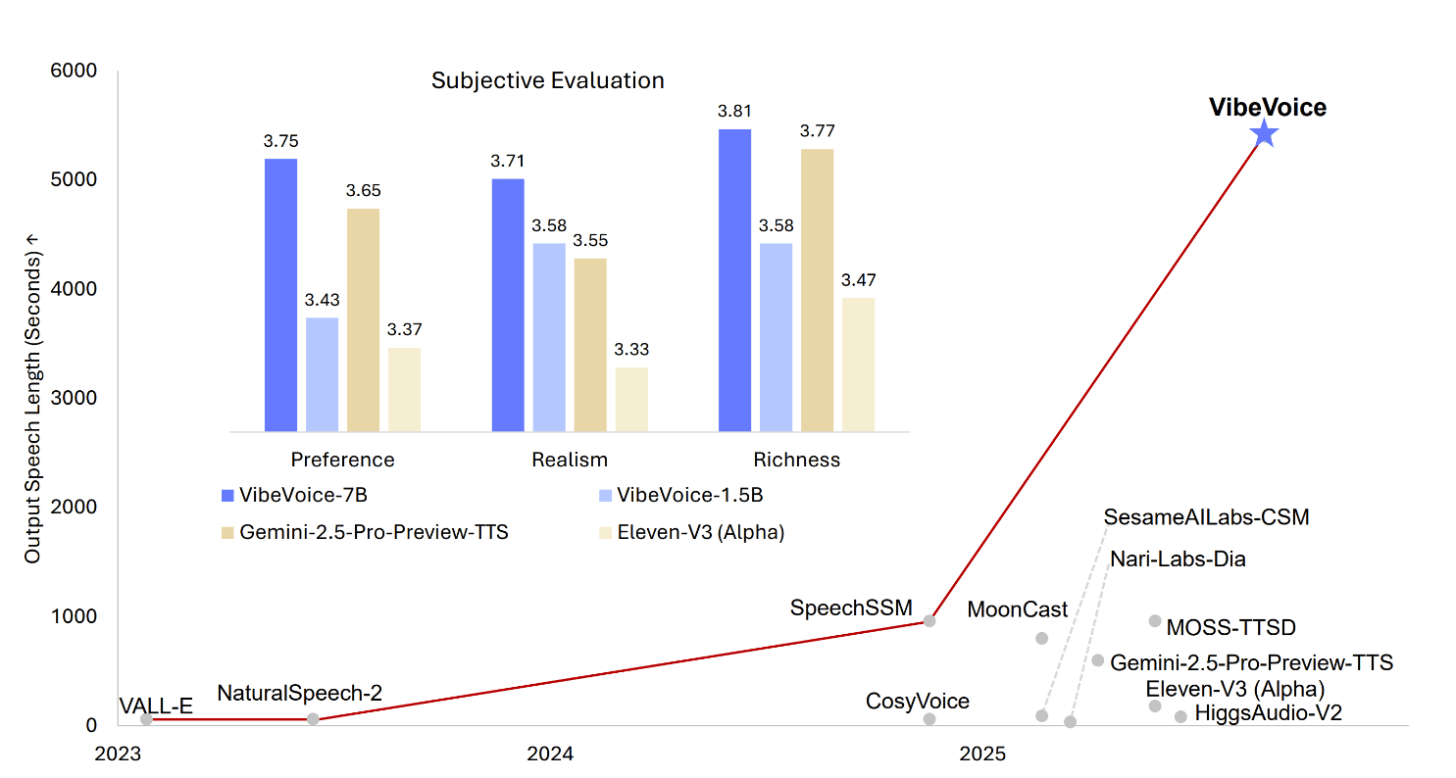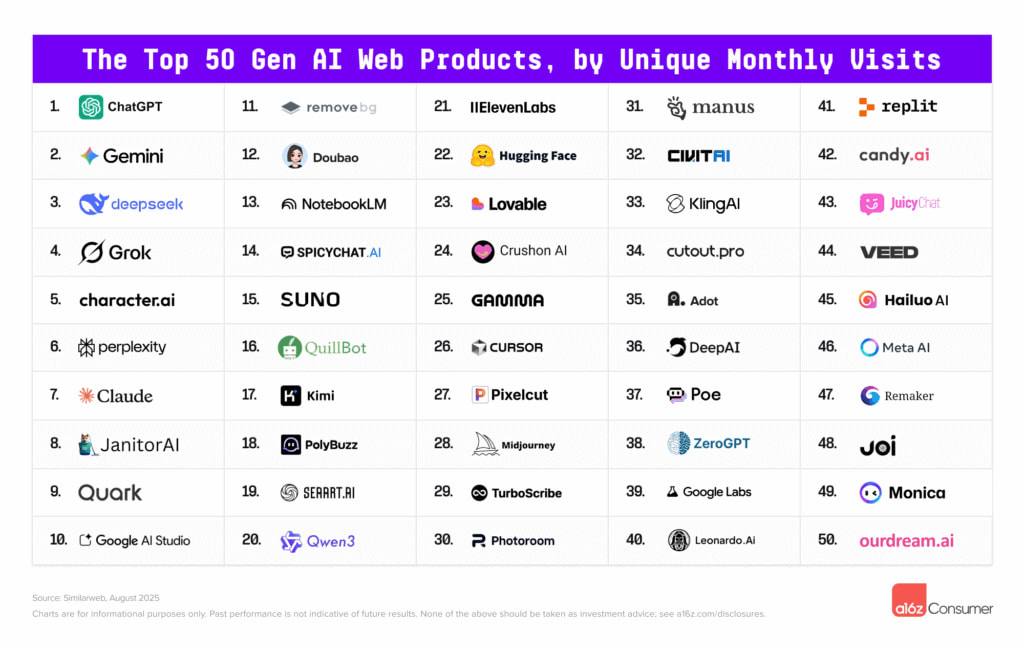Hello Engineering Leaders and AI Enthusiasts!
This newsletter brings you the latest AI updates in a crisp manner! Dive in for a quick recap of everything important that happened around AI in the past two weeks.
And a huge shoutout to our amazing readers. We appreciate you😊
In today’s edition:
🎧 Microsoft’s VibeVoice creates 90-min AI audio
📈 ChatGPT tops a16z’s GenAI app rankings
🖌️ Alibaba debuts Qwen-Image-Edit AI
🏆 Google’s Gemini Flash 2.5 tops image editing charts
📚 Anthropic reveals teachers’ top AI use cases
🩺 GPT-5 beats doctors on medical reasoning
💡 Knowledge Nugget: The Quiet Revolution: Offline LLMs and the Future of Private AI by Genevieve Smith-Nunes
Let’s go!
Microsoft’s VibeVoice creates 90-min AI audio
Microsoft has released VibeVoice, an open-source text-to-speech model capable of generating up to 90 minutes of natural, multi-speaker audio. With support for up to four distinct voices, the model produces podcast-quality conversations that maintain consistency and unique vocal traits over long stretches.
Even at just 1.5B parameters, VibeVoice performs well, using compression and Qwen2.5 to keep conversations flowing naturally. The model is lightweight enough for consumer hardware and includes built-in safeguards such as AI disclaimers and hidden watermarks to help verify synthetic audio.
Why does this matter?
VibeVoice shows how lightweight models can now generate long, natural conversations on everyday hardware, making podcasting, training, and creative projects easier. And with built-in safeguards like watermarks, it balances accessibility with accountability.
ChatGPT tops a16z’s GenAI app rankings
Andreessen Horowitz has published the fifth edition of its Top 100 GenAI Consumer Apps. OpenAI continues to dominate, but Google’s Gemini is making serious gains, ranking second and capturing 12% of ChatGPT’s traffic. Other Google projects like AI Studio, NotebookLM, and Labs also featured on the list, signaling Google’s growing presence in consumer AI. Meanwhile, Grok rose to No. 4 on the back of new releases and companion features.
The list also shows China’s stronghold in mobile AI, with 22 of the top 50 apps coming from Chinese developers, most of them popular outside China. Another notable trend is the rise of “vibe coding” startups like Lovable, Cursor, Replit, and Bolt, which are gaining traction by blending social elements with code generation.
Why does it matter?
These rankings reveal where consumer trust and traffic is actually flowing. They’re a pulse check on who is converting hype into daily use, and they hint at which ecosystems (US Big Tech, China, or new coding startups) might shape the next consumer AI platforms.
Alibaba debuts Qwen-Image-Edit AI
Alibaba’s Qwen team has launched Qwen-Image-Edit, a 20B parameter open-source model designed for both pixel-level precision and creative style transformations. Unlike many rivals, it preserves the integrity of characters and objects while allowing detailed modifications, from rotating individual elements to applying stylistic changes across scenes.
The model also brings unique features such as bilingual text editing — letting users alter Chinese and English text in images without breaking formatting — and multi-step editing that supports layered refinements. Benchmarks show Qwen-Image-Edit outperforming competitors like Seedream, GPT Image, and FLUX, making it one of the most capable open-source image editors available today.
Why does it matter?
Image generation has raced ahead, but true editing has lagged. Qwen’s open-source release, paired with models like Google’s “nano-banana,” suggests real progress towards natural language-driven, fine-grained image editing.
Google’s Gemini Flash 2.5 tops image editing charts
Google has introduced Gemini Flash 2.5 Image, an AI model designed for precise, multi-step image editing with stronger consistency and creative control. Initially tested under the nickname “nano-banana,” it quickly rose to the top of LM Arena’s leaderboard, outpacing competitors like Flux-Kontext by a wide margin.
The model supports layered, multi-turn edits, style blending, and scene mixing through natural language prompts. With multimodal reasoning it makes context-aware choices like selecting plants that fit a scene to improve realism.
Why does it matter?
If models like Flash 2.5 can layer edits and preserve detail, the next wave of editing apps may default to AI, moving from experimental demos to tools consumers actually rely on.
Anthropic reveals teachers’ top AI use cases
Anthropic analyzed 74,000 educator interactions with Claude to see how professors are adopting AI in their work. The study found that curriculum design dominates (57%), with smaller shares in research support (13%) and student evaluation (7%). Educators are also building custom tools using Claude’s Artifacts, from interactive chemistry labs to automated grading dashboards.
Why does it matter?
The findings expose a clear divide: educators lean on AI for repetitive admin tasks but keep core teaching human-led. Grading sits in the gray zone, widely adopted despite concerns about fairness and accuracy, making it the most contested frontier for AI in classrooms.
GPT-5 beats doctors on medical reasoning
A new study from Emory University shows OpenAI’s GPT-5 surpassing both GPT-4o and human medical professionals in diagnostic and multimodal reasoning. The model hit 95.8% accuracy on MedQA clinical exams, beating GPT-4o’s previous best by nearly 5 points.
GPT-5 also excelled in multimodal cases that combine patient histories with imaging, scoring 70% almost 30 points higher than GPT-4o. In expert-level tests, it outperformed pre-licensed doctors by 24% in reasoning and 29% in comprehension, even diagnosing rare conditions from complex lab and scan data.
Why does it matter?
GPT-5 surpassing doctors in diagnostic reasoning shows AI moving from a support role to expert-level performance, raising new questions about how medical practice, training, and oversight might evolve when machines outperform professionals in parts of their core job.
Enjoying the latest AI updates?
Refer your pals to subscribe to our newsletter and get exclusive access to 400+ game-changing AI tools.
When you use the referral link above or the “Share” button on any post, you’ll get the credit for any new subscribers. All you need to do is send the link via text or email, or share it on social media with friends.
Knowledge Nugget: The Quiet Revolution: Offline LLMs and the Future of Private AI
In this piece, Genevieve Smith-Nunes explores the quiet shift from cloud-first AI to locally run language models. What was once the exclusive domain of distant servers now sits on a laptop, powerful enough to generate text, analyze documents, or run code without sending data across the internet. Tools like LM Studio, AnythingLLM, and LocalAI are turning what used to be enterprise-only infrastructure into something individuals can own and control.
This shift is more than technical. It changes who holds power over data, how educators and researchers protect sensitive information, and whether institutions in low-bandwidth regions can access cutting-edge AI at all. Local models offer privacy, flexibility, and digital sovereignty, but they also bring trade-offs like hardware costs, maintenance, and static performance compared to ever-updating cloud systems.
Why does it matter?
Because who runs the model decides who holds the power. If cloud AI remains the default, Big Tech dictates the rules of access, data, and innovation. But if local AI takes root, control shifts to individuals and institutions seeking autonomy.
What Else Is Happening❗
🗣️ Microsoft unveiled its first in-house AI models, MAI-Voice-1 for fast speech generation and MAI-1-preview for text tasks, stepping beyond OpenAI reliance.
📰 Perplexity launched a $42.5M revenue-share program for publishers via its new Comet Plus subscription, giving media outlets 80% of proceeds.
🎨 Meta partnered with Midjourney to bring its “aesthetic tech” into future AI models, aiming to boost visual tools like Imagine and Movie Gen.
☀️ NASA and IBM unveiled Surya, an open-source AI that predicts solar flares 16% more accurately, aiming to protect satellites, power grids, and astronauts.
🎮 Google Cloud says 90% of game developers now use AI for tasks like playtesting, code generation, and world-building, though data rights remain a top concern.
✍️ Grammarly rolled out eight new AI agents in its Docs platform, offering tools for grading, proofreading, plagiarism checks, and reader feedback.
🛑 Anthropic gave Claude Opus 4 the power to end abusive or harmful chats, an early step in researching “AI welfare” for consumer chatbots.
📱 Google launched Gemma 3 270M, a tiny open-source AI that runs on phones and browsers, handling 25 chats on a Pixel 9 Pro with under 1% battery use.
🧫 MIT used AI to design two new antibiotics that killed drug-resistant gonorrhea and MRSA in mice, hinting at a “second golden age” for antibiotic discovery.
New to the newsletter?
The AI Edge keeps engineering leaders & AI enthusiasts like you on the cutting edge of AI. From machine learning to ChatGPT to generative AI and large language models, we break down the latest AI developments and how you can apply them in your work.
Thanks for reading, and see you next week! 😊
Read More in The AI Edge







